Lea Wait's Blog, page 41
April 10, 2024
Maine Crime Writers in Libraries
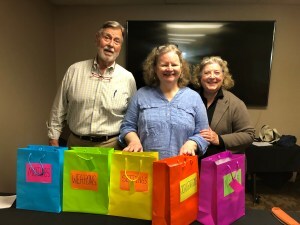 Happy National Library Week! As writers, we spend a lot of time in libraries talking about our work, doing research, and getting the next book to read. To celebrate our love of libraries, today we’re sharing photos of us in libraries. If we haven’t been to yours yet, there’s still time to plan an event for summer. Making a Mystery, with patron involvement? Casting Call: How Writers Find Their Characters, Why Maine? – Crime writers on why Maine is such fertile group for our stories, There’s a Whole Iceberg Under the Surface: Mystery Writers and the Research They Do.
Happy National Library Week! As writers, we spend a lot of time in libraries talking about our work, doing research, and getting the next book to read. To celebrate our love of libraries, today we’re sharing photos of us in libraries. If we haven’t been to yours yet, there’s still time to plan an event for summer. Making a Mystery, with patron involvement? Casting Call: How Writers Find Their Characters, Why Maine? – Crime writers on why Maine is such fertile group for our stories, There’s a Whole Iceberg Under the Surface: Mystery Writers and the Research They Do.
So here we are:
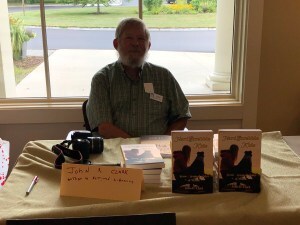
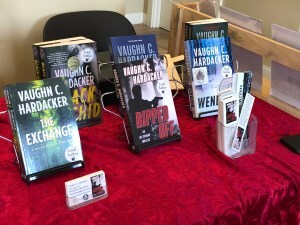
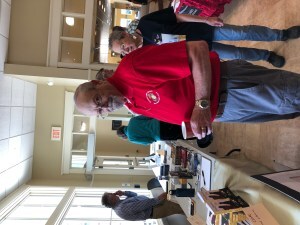
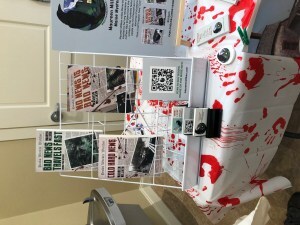


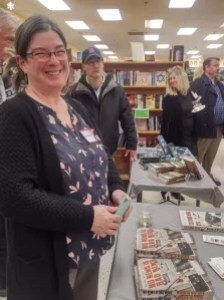
I always try to be positive and pleasant at an event, no matter how much it goes against my normal personality.
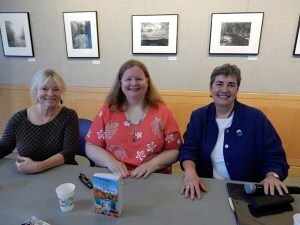
Here’s an old one . . Concord MA library, circa 2016?
Hallie Ephron, Kate Flora, Sheila Connolly, etc.

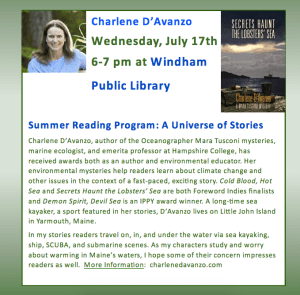
April 9, 2024
Problems of an American Mystery Crime Writer in Europe

In a long-past-due-because-of-the-pandemic-trip, we set off with great excitement – but I soon realized the biggest problem I have while traveling is starting my day in the way that makes the rest of my day ‘feel good’.
I like to complete a Morning-Write before the rest of the day gets in the way.
That means getting up early, putting in three to five hours of writing or rewriting and see the page count tick (slowly) upwards.

I use Rudolf Nureyev, the Russian dancer, as inspiration. He is famous for saying that his body was so tuned by his work-out habits that if he did not dance every day, he could not think or love or walk. Or something like that.
I can’t ballet a lick – and I was actually asked to leave a late-in-life class because my leaping across the floor was not pretty at all.

But Nureyev remains a fav because he was so damn dedicated. He said, “My feet are dogs,” when he was unhappy with his work. I say “My fingers are sticks” when there is no connection from my brain to their activity. Nureyev also said, “You live as long as you dance,” and I try to adopt his attitude to my time at my desk. Putting story ideas, characters, dialogue on the page makes me like life.
So what to do when traveling? In Portugal (where I was five weeks ago) there are no 24-hour diners or coffeeshops that open at 5 am (like Becky’s in Portland). Plus, as we know, the most common European dinner time is 8:30 or 9 pm, concerts and theatre start around 11 pm and bars and music venues stay open until 4 am. Filling the latest hours of the day with food and entertainment didn’t support my getting out of bed for my beloved Morning-Write.
 And then there are those great free breakfasts that most hotels serve or put out on buffet: they usually start at 8 am and grazing an amazing buffet of pastry, eggs, yogurt, sausages and smoked salmon takes my mind off crime and mystery writing. Why didn’t I write in bed at 5 am? The snoring from the person next to me can put me on edge. Why didn’t I just head to the lobby at 5 am? The hotel lobbies (if large enough) tend to have short drink tables, not desk-level tables, and I don’t like to type with a laptop on my lap (even though my dislike goes against the idea of what the “lap” top was designed for). And if I had enjoyed the secret speakeasy the night before (you need to know the address and where the hidden doorbell is to get in – there’s no signage because it IS secret), the early Lobby-Write wasn’t going to work.
And then there are those great free breakfasts that most hotels serve or put out on buffet: they usually start at 8 am and grazing an amazing buffet of pastry, eggs, yogurt, sausages and smoked salmon takes my mind off crime and mystery writing. Why didn’t I write in bed at 5 am? The snoring from the person next to me can put me on edge. Why didn’t I just head to the lobby at 5 am? The hotel lobbies (if large enough) tend to have short drink tables, not desk-level tables, and I don’t like to type with a laptop on my lap (even though my dislike goes against the idea of what the “lap” top was designed for). And if I had enjoyed the secret speakeasy the night before (you need to know the address and where the hidden doorbell is to get in – there’s no signage because it IS secret), the early Lobby-Write wasn’t going to work.
 And if the only time you can tour the Tinned Fish Factory in Porto (a passion for sardines is responsible for this plan) is 9:30 am and you have to take a train to the outer part of the city, so you have to leave for the station at 8:35, the Morning-Write is again dinged.
And if the only time you can tour the Tinned Fish Factory in Porto (a passion for sardines is responsible for this plan) is 9:30 am and you have to take a train to the outer part of the city, so you have to leave for the station at 8:35, the Morning-Write is again dinged.
A Noon-Write is pushed aside because I wanted to go to ‘the most beautiful bookstore in the world’ – Liveria Lello. It’s in an area of Porto that is packed with cocktail/port/wine bars and other bookstores (I’m very impressed, I must say, at the Portuguese love of books – and port).
 The stunning Lello bookstore inspired J.K. Rowling to create a similar place in her Harry Potter series. (She was teaching English in Porto and started outlining/writing Harry Potter in the city.
The stunning Lello bookstore inspired J.K. Rowling to create a similar place in her Harry Potter series. (She was teaching English in Porto and started outlining/writing Harry Potter in the city.

Maybe J.K.’s why you now have to pay 8 Euro to go inside the bookstore (but if you buy something, the 8 Euro goes towards it so you get this great feeling you’re getting 1/3 off a book – which of course you’re not, but still…).
And Afternoon-Write was only partially successful because I wanted to hang out at the ‘oldest café in Porto’ – the Majestic. It’s gorgeous, built in 1921, in the ‘La Belle Epoque’ era, and is complete with glittering chandeliers, swerve-y arches, cupids and wild-shaped windows and mirrors.

 Smartly dressed waiters sweep over and give you a menu that lists lots of coffees and ports and cocktails. The most incredible food-treat was a quickly-dipped- and-fried French Toasts served with bananas and drowned in maple syrup.
Smartly dressed waiters sweep over and give you a menu that lists lots of coffees and ports and cocktails. The most incredible food-treat was a quickly-dipped- and-fried French Toasts served with bananas and drowned in maple syrup.

A blurb on the café reads: ‘This cafe used to be the meeting point of the elite of the city. Writers, politicians, royals, musicians, artists, and thinkers exchanged ideas here and discussed different topics over a cup of coffee or a glass of absinthe. Once you walk through the main doors it’s like you’re taken back in time, and you can feel and hear the ideas, stories and conspiracies that took place at those tables.’

J.K. Rowling spent time at the Majestic too. The café’s website states that she ‘scribbled down notes on napkins while enjoying a coffee break in Café Majestic’ and it’s noted that she even started HP, Book One here. (I got too into rubber-necking and drinking white port and eating French Toast to write more than a page.)
And then we had to walk off the tasty pastry, and there were city hills to climb, port distilleries to visit (get the history of and taste-test the fine products), art and fashion to admire and then one had to take a sunset boat ride on the river. So, the Just-Before-Serious-Cocktail-Write had to be put aside.
I have to admit, Dee Rommel didn’t even get much ‘thinking’ time in Porto. That had to wait until we reached our AirBnB in Florence – where the novelty and ‘tourist mindset’ had worn off years ago when I spent long stretches (four months at a crack) teaching screenwriting there (four years in a row and I still can’t converse in Italian). The Morning-Writes didn’t start until 7 am (damn that late night life) – but the routine was back in place in a series of cafés filled with lots of other writers (some students) on laptops at tables set at a perfect desk-height.
And Dee Rommel was joined by Los Angeles based Bennet Azuolo, a very private detective sent to Florence to find the missing wife of the very rich Vermont Parka King. I want Bennet to ‘star’ in a series of short stories that take place in Florence. One down. We’ll see if more follow…
April 8, 2024
The Coldest Winter I’ve Ever Spent Was Sprimg in Maine!

Ahhh, spring. The most welcome change of seasons. Budding trees. Tulips popping up. The optimism of another Red Sox season. Bruins and Celtics playoffs. New spring novels.
Think against!
After a mild and temperate winter, spring came in like a wolf. Two violent and destructive storms blew in and threw my writing off course. The weather is definitely changing, creating more of these dangerous ice storms. This wintry mix is proving more lethal than most of the other times of storms we receive. The trees cake thick with ice. The added weight probably increases tenfold when this happens, creating dangerous conditions when the limbs can no longer support such weight.
And then there is the loss of power. I lost it for two days. Do you know how hard it is to write when your computer has no power and the internet is out? I don’t write longhand. In fact, without my computer or television, I actually had to grab a book off my shelf and read the old fashioned way. And I really enjoyed the experience.
The irony of the storm was that I had a tree come down across my driveway. My wife decided to park in the garage the night before the storm. When I came home, I asked her why she had done that. The storm would be a nothing burger, I said. It was one of the few times she had parked it inside. Wouldn’t you know, that tree came down exactly where she always parked. Our truck would have been totaled otherwise. Not only that, but the tree just missed destroying our garage. And the irony was that it was my neighbors tree that came down, and I had ten trees cut the summer prior.
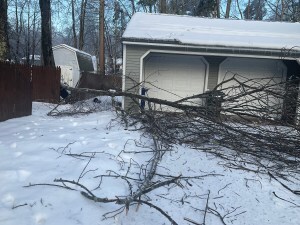
On the plus side, Portland looked like a winter wonderland for two whole days. Me and the wife went out of our cold house and went for lunch and dinner and a Mariners hockey game. We had fun until we had to return to our freezing house.
Monday came and no power, which meant no writing would get done. I went to the gym where I forgot to shower. I was supposed to meet a friend for lunch and had to take a freezing cold Navy shower at home. Burrrrrrr!
That night the power returned. What a relief. Back to writing. And then two weeks later we get another spring storm. Although the wind was worse, at least we didn’t get the icy rain. And we didn’t lose power, which meant I had a cozy day at home writing and watching Buddy bake cakes.
Well, the snow is now melting and spring is finally here. I think we are out of the woods now. I do love spring, but in Maine it can often be the cruelest and most harshest of months. Mark Twain once said, “The coldest winter I ever spent was a summer in San Francisco.” Well, Mr. Twain, come visit in Maine sometime in the spring.
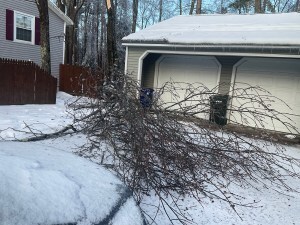
April 5, 2024
Weekend Update: April 6-7, 2024
 Next week at Maine Crime Writers there will be posts by Joe Souza (Monday), Jule Selbo (Tuesday), Vaughn Hardacker (Thursday) and Rob Kelley (Friday).
Next week at Maine Crime Writers there will be posts by Joe Souza (Monday), Jule Selbo (Tuesday), Vaughn Hardacker (Thursday) and Rob Kelley (Friday).
In the news department, here’s what’s happening with some of us who blog regularly at Maine Crime Writers:
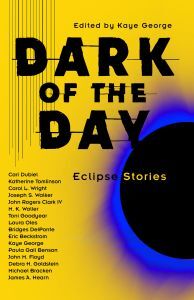
John Clark has a story in this new anthology:
Dark of the Day: Eclipse Stories, Edited by Kaye George
Print ISBN-13: 978-1-64396-395-2 Publication Date: April 1st, 2024
An anthology of stories to celebrate the April 2024 eclipse in North America. These stories are located in various places and are even of various genres and themes. What they have in common, besides featuring eclipses, are that they are all written by brilliant authors and will all entertain you. Read them before the eclipse, to get into the mood, or after, to nostalgically remember it.
During the darkness, all manner of things can happen. When people are distracted by this spectacular celestial event, criminals can operate unimpeded, they can also be caught.
Trips to see the event can lead to disaster, or they can save the day. And the science of looking at the sun becomes important when a partner strays.
The event can mean many different things to a disaster cult, to drug-dealing Russians, to an artist striving for his grand opus.
It spreads across the country to, maybe, give confirmation to a program to analyze the universe, to give a gift to a mermaid in an abandoned water park, to show what the crazy guy at the fast food place is really like, to help a young girl find her way.
As a not-so-clever crime goes awry, a hike to view the spectacle is interrupted.
Contributors include Cari Dubiel, Katherine Tomlinson, Carol L. Wright, Joseph S. Walker, John Rogers Clark IV, M. K. Waller, Toni Goodyear, Laura Oles, Bridges DelPonte, Eric Beckstrom, Kaye George, Paula Gail Benson, John M. Floyd, Debra H. Goldstein, Michael Bracken, and James A. Hearn.
An invitation to readers of this blog: Do you have news relating to Maine, Crime, or Writing? We’d love to hear from you. Just comment below to share.
And a reminder: If your library, school, or organization is looking for a speaker, we are often available to talk about the writing process, research, where we get our ideas, and other mysteries of the business, along with the very popular “Making a Mystery” with audience participation, and “Casting Call: How We Staff Our Mysteries.” We also do programs on Zoom. Contact Kate Flora
Sometimes The Good Die Young For A Reason
John Clark is way ahead of his reading goal, having enjoyed 66 books in the first three months of 2024. And, yes, I also find time to write along with selling used books, and entering sweepstakes. Retirement, when approached properly gives one the freedom to pick and choose what to use their time for. I just started volunteering at granddaughter Piper’s school, where Beth has done for a couple years now. Mentoring is resuming at the Alfond Center, something I’ve done for the past several years, and I facilitate an AA meeting at the Somerset County Jail at least once a month. Then in June, I’ll be a delegate at the state Democratic convention. Boredom…Nah, I sold that in Uncle Henry’s years ago.
One aspect of being an avid reader is the number of interesting new books I discover. My TBR list runs 48 pages long and add new stuff almost every day. There are, however, some intriguing books that never appear in any Maine library. Those I buy, read, review, and pass on to the Waterville Public Library so they can add them to their collection, and by proxy to MaineCat, the statewide catalog. Today, I’m reviewing a few of my more recent reads. Some are mysteries, others very good YA fiction
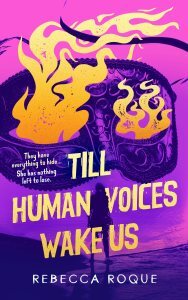
Till Human Voices Wake Us by Rebecca Roque Blackstone Publishing 2024 9798212631051. This is about as complex and intriguing as a first novel could be. Cia’s seventeen and lives with her two dads who adopted her after her father set fire (or did he?) to their home, killing her three sisters and her mother. She barely survived, having sustained severe burns to her extremities. She lost one leg, but has adapted well enough to be a champion runner.
Shortly after an argument with her best friend Alice, said friend is found floating in a local quarry. The official story is suicide by drowning, but Cia knows Alice would never have killed herself. As she looks more carefully at the situation, she discovers that a scarily high number of other teens disappeared, many later turning up dead with sketchy death certificates. Add in a suspicious clinic, a drug known as bone dust, plus more secrets than you can imagine. I could go on for a long time about how much the author packed into this book. There are people who are seemingly good, but are not, and the reverse is true. If you want a dandy page-turner that will continue in at least one more book, this one is for you.
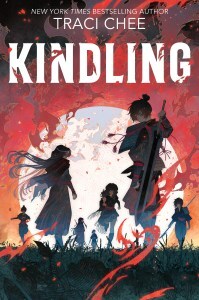
Kindling by Traci Chee, Harper 2024 9780063269354, is a retelling of the Seven Samurai legend set in a war-torn fantasy world where young men and women were used as weapons and called Kindlings. Most were given a pat on the back, if even that once the war ended and cast adrift. Each had a special ability, but paid a steep price because using that ability slowly ate them up until they reached a point where recovery was impossible.
Told in alternating chapters, starting with Leum who wants to find enough money so she can get past civilization and live in the shadow of a remote mountain, this is the story of how a determined girl from a poor village convinces seven Kindlings to band together and protect her village from bandits. Each of the seven are cynical and initially resistant, but once they are rounded up and begin planning their defense including cutting trees to make spears and fortifications, they coalesce.
Despite their individual hardness, all seven are very appealing characters. The overall tone of the book is grim and there’s plenty of bloodshed, but that doesn’t prevent it from being one heck of a read.
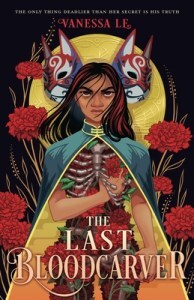
The Last Bloodcarver by Vanessa Le, Roaring Brook Press 9781250881526. This is a blend of mystery, dystopia, and fantasy. Nhika scrambles to survive every single day. Her father drowned at sea and her mother died not long after, leaving her an orphan on the streets of a hostile city. She has a gift, but one that, if revealed, could get her killed or captured by a gang called the Butchers, who would have no qualm about selling her to the highest bidder.
When she uses the gift to enter the body of a dying woman by placing her hands on her, she dissolves a blood clot in her neck, saving the woman’s life. She disguises what she did by telling the husband she used herbal tinctures. Instead of gratitude, he calls the Butchers and she tries escaping from a second story window. Unfortunately, she’s captured and sold for a mind-boggling sum. Her buyer is the daughter of a recently deceased industrialist. The daughter, her brother, and the brother’s assistant all believe Nhika might be able to use her abilities to reverse the brain injury their late father’s assistant suffered during the ‘accident’ that killed the father and reveal exactly what happened.
What ensues is her getting a mental and physical reprieve while living in unexpected luxury and attempting to heal her new patient. However, the mysterious assistant to the family physician is alternately flirtatious and hostile, leaving Nhika confused. Add in what really happened to the father, who the evil person behind the curtain is, and one of the most unusual endings I’ve seen in years, and you have a dandy tale
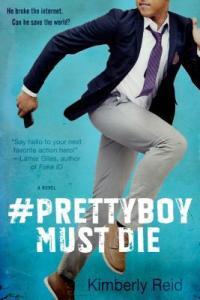
Prettyboy Must Die by Kimberly Reid Tor Teen 2018 9780765390882 This will require a dash of suspension of belief, but it’s well worth it. Imagine a Black teen working in the Eastern Ukraine for the CIA, helping bust illegal arms smugglers. This is how we meet Jake Morrow, AKA Prettyboy. While the bust is partially successful, the son of the mastermind escapes, as does the teen hacker employed by the bad guys.
This lands Jake, under an assumed name, at a fancy Colorado boarding school where he suspects the hacker has also enrolled. His roommate, Bunker, so nicknamed because his dad was a doomsday prepper and kept him in a bunker until he was seventeen, is a fun character. He’s slightly nuts and socially awkward, but capable of saving the day at unexpected moments.
When three creepy men and a woman pretending to be a police detective enter the school, ostensibly to question Jake, but really there to exact revenge, he hides, triggering the bad guys’ lockdown of the school. What ensues is a mix of comedic and tense moments that involve figuring out how to find a phone or computer that hasn’t been locked down, maneuvering through the ventilation system, not to mention rescuing another student who’s even more sought after than Jake, plus an attractive teen spy with a British accent, but is she the hacker, the enemy, or something else? It’s a very fast and fun read.
April 3, 2024
FINAL STORM REPORT OF THE SEASON!
If you’re reading this on April 4 that means you have power or at least internet. Congratulations!
Today’s yet another spring surprise, an April storm that forecasters promise will yo-yo from rain to snow to sleet to who knows what. The wind will blow, the precipitation will be heavy, the roads will be treacherous, power lines will come down. If you aren’t able to read this on April 4, I hope you’re tucked in at home with a good book.
To distract us from what’s happening outside the window, here are some thoughts, observations and news about spring:
MAINE CRIME WAVE is going to be amazing this year. Mark your calendars for Friday evening, June 14 and Saturday, June 15, when the ‘wave rolls through the USM campus in Portland. Michael Koryta is this year’s Crime Master. If you haven’t read any of his New York Times bestselling books, you’re missing out. Here’s a link to his website to give you a sense of Michael and his work: https://www.michaelkoryta.com/
Juliet Grames of SoHo Press is the keynote speaker, and our own Kate Flora will be honored with the Lea Wait Award in memory of our departed but never forgotten dear colleague. 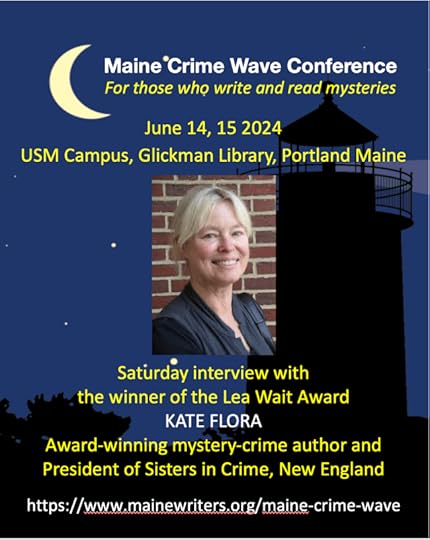 There’ll be panels and craft workshops and lots of time to schmooze. Writers with years of experience and those just starting out are equally welcome, and so are readers of crime fiction (after all, we do it for you). Maine Crime Wave is a not-to-be-missed event, so register early.
There’ll be panels and craft workshops and lots of time to schmooze. Writers with years of experience and those just starting out are equally welcome, and so are readers of crime fiction (after all, we do it for you). Maine Crime Wave is a not-to-be-missed event, so register early.
Here’s the link: https://www.mainewriters.org/calendar/crime-wave-early-bird
MARCH MADNESS now spills over into April, and that’s fine with me, especially when the likes of Caitlin Clark (41 points, 12 assists, 7 rebounds against a very talented LSU team earlier this week) and her Iowa Hawkeye teammates are on the TV. The Final Four is this weekend, and like most of the nation, I’ll be tuning in to the women’s games—Iowa v. Connecticut and South Carolina v. North Carolina State—what matchups! The men’s bracket Final Four bracket is fine, but if you enjoy electric basketball, the women are where it’s at this year.
FLOWERS! They’re blooming under the snow and I have it on good authority that crocus and daffodils are resilient as can be. So when this all melts, they’ll still be around to brighten our winter weary yards.
BIRDS! The goldfinches are turning blaze yellow (a prettier cousin to blaze orange), red-winged blackbirds have been serenading us for nearly a month, we heard a white-throated sparrow singing her heart out one evening last week and a pair of bluebirds have been regular customers at the mealworm feeder in our yard. Get outside with or without binoculars and watch for migrating birds coming home to Maine for the summer. It’ll cure whatever ails you.
THE ECLIPSE! Monday afternoon. Don’t miss it but protect your eyes, ok?
MECHANICS HALL in Portland is a treasure, a historic space that features a wonderful library and terrific performance space. Over the past decade it’s become a go-to place for readings and musical events, and pretty much everyone who visits is awed by its historic and present-day value to the community. Last week a $2,860,000 federal grant was announced, money that will support restoration work that’s been ongoing for several years. A press release from the Maine Charitable Mechanics Association thanked Maine’s two U.S. Senators for their leadership in obtaining the funding, which the association said will “enable us to address active leaks threatening the integrity of our 165-year-old building and to repair the iconic clerestory roof and granite exterior. This funding, part of a bill for Maine Community and Economic Development Projects for Fiscal Year 2024, has effectively saved our historic landmark building.” I say hooray for that. For more information about the Maine Charitable Mechanics Association, its beautiful building and the amazing events that happen there, go here: https://mechanicshallmaine.org/
THE BOSTON RED SOX are seven games into the season and they are 5-2. All the pundits are down on them, but I believe they’ll be better than expected this season. The Sox always have been my team and they always will be. I’m not going to say much more, because I believe in jinxes as much as the next fan, but Go Sox!
THE BEACH, as readers of this blog know, is one of my favorite places to walk and take photos. Here’s a wash of beautiful spring sunshine on the waves that I hope portends a good season ahead now that this final storm is behind us.

Brenda Buchanan brings years of experience as a journalist and a lawyer to her crime fiction. She has published three books featuring Joe Gale, a newspaper reporter who covers the crime and courts beat. She is now hard at work on new projects. FMI, go to http://brendabuchananwrites.com
April 2, 2024
Taking a Month Away
Kate Flora: Since my husband began nudging toward retirement, we’ve been taking the month of March away. For years it was on Sanibel, in Florida, until Hurricane Ian wrecked the island. Last year, unable to face the devastation or search for a new place to stay, we went west, and brought rain (one of our special talents) to Santa Barbara, LA, St. George, Utah, and Sedona, Arizona. It was a lovely three weeks of walking in new climates and we loved it. But hearts were still on Sanibel (although not Florida in general) and so this March just past, we spent a month in a rental in Naples.
Naples is one of those places where people drive such expensive cars that I joke a BMW or a Porsche are like Corollas. Bentleys all over the place and jerks with Maseratis roaring around late at night just to hear themselves make noise. The traffic lights are endless, and force us to practice a patience we don’t possess.
But the birds are happy.
Today, I am just out of the car after driving back for the past three days. My sciatica is in full roar. There are piles of stuff everywhere that need to be put away or disposed of or washed or responded to. There are large downed branches everywhere and the gardens are full of pinecones, but luckily no trees came down. Reentry is always a challenge.
And yet, how can I complain about lush foliage, beach walks, visits with good friends, a


trip to the botanical garden, a walk with alligators, or more time to sit by a pool and read? I even got a good start on the next Joe Burgess book, Deliver Us from Evil, by trying to stick to a 1000 word a day schedule. I didn’t always make it, but I am 30K into the new book, and enjoying the adventure.
So while I ought to be writing a thoughtful blog about something Maine or writing related, I am reminded that sometimes stepping away from the desk and observing can recharge the creative well. So here are few photos from a walk around Savannah, which is a lovely place to stop and break up the drive. And yes, the white cat is real.




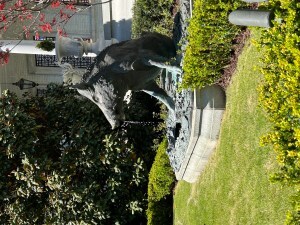



March 31, 2024
Finding the Right Cover
Kaitlyn Dunnett/Kathy Lynn Emerson here, today writing as Kathy and following up on my last blog about revising Firebrand, a 1993 historical romance, into historical fiction (tentatively titled Treacherous Visions). The manuscript is now “resting” for at least a month, after which I will do at least one more revision before publishing it in trade paperback format. It is currently 78,514 words in length, down from the 90,628 I started with. The original novel was even longer than that, since I did some judicious cutting when I reissued it as an e-book back in 2005.
It’s at this point that I need to consider cover art. When rights to a piece of writing are returned to the author, that’s all she gets back. The cover art is not included. In this case, that’s just as well. Firebrand had three covers, one for the U.S., one for the U.K., and one for the German edition. None of them were an accurate representation of the book’s content then and they certainly aren’t now. Here’s the original U.S. cover:
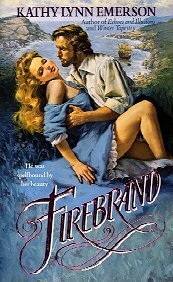
And the one from the U.K:

And the German version:

And, oh yes, the cover on the e-book currently available:

So what kind of cover do I want for Treacherous Visions?
The story is set in the 1630s. It starts in London but moves to Colonial New England for most of the action. Everything was wilderness back then, but what is now the State of Maine was even more so. The artwork on the back cover of Firebrand came closest to representing my characters’ Pilgrim neighbors, but again, I can’t use this artwork
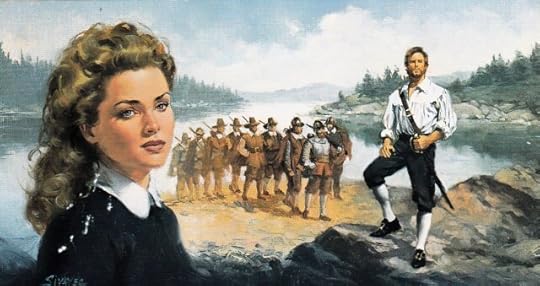
Shalla, a novel I wrote for young readers age 8-12 and self-published a couple of years ago, is also set in Colonial New England. In an early incarnation, I created a cover using part of a painting in the public domain, but when it came out as a paperback, I hired someone to design a cover. I’m quite pleased with it, but I don’t want to duplicate it for Treacherous Visions. Here’s my version:

And the one I now use:

At the same time I’ve been working on revising this novel, I’ve also been proofreading and formatting the first book in my Face Down Mystery Series, Face Down in the Marrow-Bone Pie. It should be available very soon in a trade paperback edition, the first print edition since the original hardcover and mass market paperback editions went out of print. The other books in the series will follow. The titles, all starting with the words Face Down, let readers know they are connected, but I also wanted the covers to convey a common theme. Since the books are set in Elizabethan England, I’m using maps published in the sixteenth century—they’ll show the county or city in which that particular mystery takes place. Here’s the first one, designed using Canva by my clever husband.
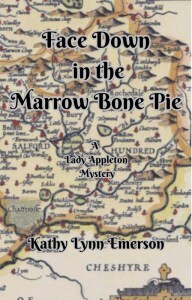
I’m tempted to use a map background for Treacherous Visions, too, since setting is so important to the story. I have a wonderful 1570 map of the area showing the old place names. Norumbega was the one given to New England and is also the name of the legendary lost city my heroine’s love interest is trying to find.

What do you think? Would this map work as cover art for historical fiction with a hint of the paranormal? Or would it just confuse readers into thinking this novel is part of the Face Down series? Comments and alternate suggestions are very welcome.
Kathy Lynn Emerson/Kaitlyn Dunnett has had sixty-four books traditionally published and has self published others. She won the Agatha Award and was an Anthony and Macavity finalist for best mystery nonfiction of 2008 for How to Write Killer Historical Mysteries and was an Agatha Award finalist in 2015 in the best mystery short story category. In 2023 she won the Lea Wait Award for “excellence and achievement” from the Maine Writers and Publishers Alliance. She was the Malice Domestic Guest of Honor in 2014. She is currently working on creating new omnibus e-book editions of her backlist titles. Her website is www.KathyLynnEmerson.com.
March 29, 2024
Weekend Update: March 30-31, 2024
 Next week at Maine Crime Writers there will be posts by Kaitlyn Dunnett/Kathy Lynn Emerson (Monday), Kate Flora (Tuesday), Brenda Buchanan (Thursday) and John Clark (Friday).
Next week at Maine Crime Writers there will be posts by Kaitlyn Dunnett/Kathy Lynn Emerson (Monday), Kate Flora (Tuesday), Brenda Buchanan (Thursday) and John Clark (Friday).
In the news department, here’s what’s happening with some of us who blog regularly at Maine Crime Writers:
Matt Cost would like to welcome PIRATE TRAP into the family. This fifth book in the Clay Wolfe/Port Essex Trap series was born on Wednesday, March 27th, at a height of 8.5 inches and a robust weight of 13.4 ounces. Wednesday, April 3rd, Cost will be at the Baxter Library in Gorham speaking about the evolution of Pirate Trap at 6:00 p.m. On Saturday, April 6th, Cost will be on a panel of authors at the Exeter LitFest in New Hampshire playing two truths and one lie at the Sea Dog Brewery at 10 a.m. Kate Flora will also be there.
Kate Flora is both thrilled and astonished to learn she’ll be receiving the Lea Wait Award at the Maine Crime Wave this year. If you haven’t been to the Wave, you’re missing out on a great weekend and a chance to meet authors and hear their tips. Crime writers are a community, and this our Maine gathering.
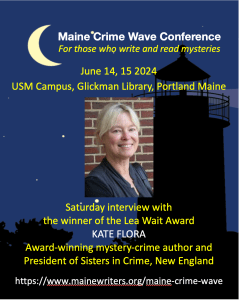
https://www.mainewriters.org/maine-crime-wave
An invitation to readers of this blog: Do you have news relating to Maine, Crime, or Writing? We’d love to hear from you. Just comment below to share.
And a reminder: If your library, school, or organization is looking for a speaker, we are often available to talk about the writing process, research, where we get our ideas, and other mysteries of the business, along with the very popular “Making a Mystery” with audience participation, and “Casting Call: How We Staff Our Mysteries.” We also do programs on Zoom. Contact Kate Flora
March 28, 2024
Actually Useful Writing Books
Kate Flora: Over the years, I accumulated quite a library of reference books related to writing, to crime writing in particular, and to crime investigations of all sorts. I never stop acquiring books that someone I regard as credible has suggested. This week I added The Bestseller Code: anatomy of a blockbuster novel. I usually find these unsatisfying but I’ll give it a try. For writers beginning to crime writing journey, Hallie Ephron’s Writing and Selling Your Mystery Novel is a fabulous reference, and one I return to time after time. Also an excellent reference is How to Write a Mystery: a Handbook from Mystery Writers of America. And for writers learning to embrace revision, Elizabeth Lyon’s Manuscript Makeover: Revision Techniques No Fiction Writer Can Afford To Ignore. Of course, I also have a zillion books on injuries, criminal psychology, practical homicide investigation, writing suspense, etc.
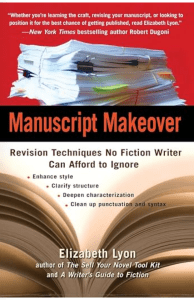


Kaitlyn Dunnett/Kathy Lynn Emerson: My “how-to” book collection is pitifully small and most of it dates back to the 1970s and 1980s when I was first trying to learn the craft. Those books are both out of print and out of date. So, for what it’s worth, I’m going to plug the writing book I wrote and which I recently reissued in a slightly revised and updated trade paperback edition. It’s also available as an e-book.
HOW TO WRITE KILLER HISTORICAL MYSTERIES won the 2008 Agatha Award for best nonfiction. Marv Lachman, reviewing it in Deadly Pleasures, described it as “the best book about writing mysteries that I have ever read.” Most of my updates are in the sections on self-publishing and marketing, where there have been massive changes in the industry since 2008. All the good stuff is the same.
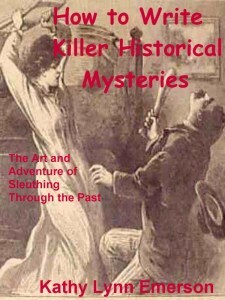
The original version (which has a different cover) was written while I was still writing my Face Down series, featuring Susanna, Lady Appleton, sixteenth-century gentlewoman, herbalist, and sleuth, and had just published the fourth book in my Diana Spaulding 1888 Quartet. It’s my take on writing historical mysteries, but it also contains input from many other writers of historical mysteries. They include longtime friends like Sharan Newman, Rhys Bowen, and the late Carole Nelson Douglas, who offer their insights into what it takes to mix history with mystery, as well several writers I’ve never met (Lindsay Davis and Kerry Greenwood, to name just two), who were also extremely generous in offering advice and letting me quote them on a variety of historical-mystery-writing topics.
Kait Carson: Two of my bookshelves are filled with writing books. Some (not many) I’ve read. Mostly, I run my finger across the spines and hope to absorb whatever I need at that moment. There are three I return to again and again. The Emotional Thesaurus by Angela Akerman and Becca Puglisi, helps to vary up the language and provides great show don’t tell language. Chris Roerden’s Don’t Murder your Mystery is the last edit check before the book is ready for prime time beta readers. On Writing by Stephen King. Not for the craft advice, but for the shot of energy it gives me when I’m flagging.
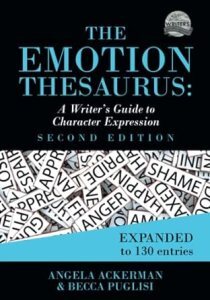


John Clark: For beginning writers, high school students and local adult education classes, I still think What If? Writing Exercises for Fiction Writers Paperback – November 20, 1991 by Anne Bernays (Author), Pamela Painter (Author) is an excellent book to use.

Matt Cost has always been an odd duck. I’ve never read books on writing as I don’t believe that it can be taught, only practiced, honed, and improved through the process. My fear is that writing craft books will swerve me from my own style and take my unique style and mold it into a Christmas cookie. But I do use a variety of books for research! Books on voodoo, cults, Brooklyn, New Orleans, the Civil War, and Joshua Chamberlain. Bonus points if you can match the research books to my written novels.

Jule Selbo here. I have read a lot of books on story structure – most that focused on screenwriting since that was my profession for many years (books that helped me make my living as a writer which was the best thing ever – for me).

Syd Field’s book, written in 1979, was the first one I grabbed from a bookstore when my playwriting agent told me I had to write for tv and film so “we” could make money. It was helpful – he laid out story structure in a very comprehensible way – and I also got to know Syd a bit and he was a generous with his knowledge.
 Then I went backwards in time and found France Marion’s book (1937, she won an Academy Award for her screenplay – The Champ – in 1931, was best buds with Mary Pickford, wrote comedies and dramas and movies that help change the prison system (The Big House 1930). Her approach was simple, made a big impression on me.
Then I went backwards in time and found France Marion’s book (1937, she won an Academy Award for her screenplay – The Champ – in 1931, was best buds with Mary Pickford, wrote comedies and dramas and movies that help change the prison system (The Big House 1930). Her approach was simple, made a big impression on me.
 Clare Beranger’s – (1950 book, she was a screenwriter in early Hollywood and then started what became USC Film School). Smart, incisive and
Clare Beranger’s – (1950 book, she was a screenwriter in early Hollywood and then started what became USC Film School). Smart, incisive and
 Then back to Chris Vogler (who took Joseph Campbell’s fabulous work and adapted Campbell’s story evolution and ideas to screenwriting). Everything was helpful – for different reasons. (I think Vogler’s structure layout is best for the classic superhero and epic film stories.) I even wrote two “how-to” books for screenwriters (structure book (2010) and story genre book (2014) after working in the craft/business for few decades and I still find them helpful because they reflect on I landed on a way to approach story that made sense to me.
Then back to Chris Vogler (who took Joseph Campbell’s fabulous work and adapted Campbell’s story evolution and ideas to screenwriting). Everything was helpful – for different reasons. (I think Vogler’s structure layout is best for the classic superhero and epic film stories.) I even wrote two “how-to” books for screenwriters (structure book (2010) and story genre book (2014) after working in the craft/business for few decades and I still find them helpful because they reflect on I landed on a way to approach story that made sense to me.

 When I moved into writing novels, I became obsessed with studying how writers could “keep me reading even when I had other things I needed to do” . For me, there are so many books that are excellent, and then there are the ones that I am not sure if they are excellent – but they drag me back to my reading chair even when I am supposed to be doing something else. And I love trying figure out how the writers of those books “do that”. Is it their building of characters? Filling out the life of the people/the crime/ the reasoning/the world? Right now – I read and read mysteries/crime novels and re-read the ones that I can’t put down and try to suss out the reasons…
When I moved into writing novels, I became obsessed with studying how writers could “keep me reading even when I had other things I needed to do” . For me, there are so many books that are excellent, and then there are the ones that I am not sure if they are excellent – but they drag me back to my reading chair even when I am supposed to be doing something else. And I love trying figure out how the writers of those books “do that”. Is it their building of characters? Filling out the life of the people/the crime/ the reasoning/the world? Right now – I read and read mysteries/crime novels and re-read the ones that I can’t put down and try to suss out the reasons…
Rob Kelley: As is the case for many writers, Anne Lamott’s Bird by Bird was influential for me with her concept of the shitty first draft. There is something so freeing about getting out of your own way and getting words down on paper. But my new favorite writing advice book isSeven Drafts by Allison K. Wilson, primarily because it helped me have a path for how to fix everything without trying to fix it all at once. She outlines seven drafts: The Vomit Draft (first draft), then describes subsequent ones on plot, character, technical matters, copy editing, beta reading, and editor reading. In working on my most recent novel, I used them all, plus a few more that helped correct mistakes I always make. It was a great way to have a plan to work against when facing the chaos of a work in progress!
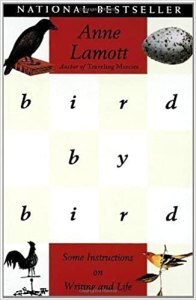
Maggie Robinson: I probably should read each and every one of these. I only took one writing class in college, Persuasive Writing. I don’t believe I ever persuaded anyone of anything, and whatever textbook we used is long gone. Over the years I’ve sat through numerous craft workshops with book suggestions, but like Matt have resisted reading them. Maybe I’m just lazy. However, I can second Kait’s rec of Stephen King’s On Writing, even if I am still shamelessly larding my prose with adverbs.
Lea Wait's Blog
- Lea Wait's profile
- 509 followers



